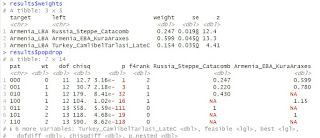Genetic history of Levant. Part A.
Tuesday, December 24, 2024
Genetic history of Levant. Part A.
Saturday, December 21, 2024
Alashkert Armenians have quite remarkable genetics.
Thursday, December 19, 2024
Genetic history of Greece
Genetic history of Greece
Sunday, December 15, 2024
Attempt to redo the models from recent papers.
Attempt to redo the models from recent papers.
- Armenia LBA as a simple mixture of Kura-Araxes and Catacomb is a failure. P value too low. ( pic. 1)
- Addition of an Anatolian population like Ikiztepe C improves the p value. This was done in Skourtanioti 2024. The model is feasible. p=0.2
- The use of CamlibelTarlasi_LateC instead of Ikiztepe improves the p value even more. Done in Yediay 2024. p more than 0.3
- An addition of Leila tepe culture (from what is now Azerbaijan) instead of Anatolian C improves the p value much more. p more than 0.7. But the standard errors increase a lot because the Kura-Araxes and Leila tepe are too close genome wide to each other. To reduce the standard errors I need to change the settings (right pops). This will require a time from me. But I think its quite obvious what is going here.
- And finally I add the Ukraine N hunter gatherers to the source and the p value reaches practically 0.9, close to certitude. The standard errors also improves slightly, but still requires improvement.
Thursday, December 12, 2024
Before I review the recent Yedia et al. 2024 preprint few comments are needed about this chart.
Before I review the recent Yedia et al. 2024 preprint few comments are needed about this chart.
Monday, December 2, 2024
One of Greek samples from Hovhannisyan 2024 is located in the modern Armenian cloud.
One of Greek samples from Hovhannisyan 2024 is located in the modern Armenian cloud. I couldn't find any information about him except that Greek DNA used in the paper was from Lazaridis 2014 Nature.
Saturday, November 30, 2024
A new alphabetic system was apparently discovered in north Syria.
A new alphabetic system was apparently discovered in north Syria. It can be the oldest alphabet known. Dated at 2400BC.
Thursday, November 28, 2024
I made this map to explain how modern Armenian genetics has formed.
I made this map to explain how modern Armenian genetics has formed. The map shows the genetic situation in Middle Bronze Age thus 4000 years ago. I deliberately selected those colors to emphasize the clinal nature of this situation.
Wednesday, November 27, 2024
Hovhannisyan et al
Hovhannisyan et al. 2024 published for the first time 5 genome wide DNA samples of Sasun Armenians. Until now we had only Y DNA studies about Sasun Armenians which showed that their Y DNA pool is different from other Armenian subgroups (see picture 2). Various theories has been proposed to explain this difference based on historic records and legends.
Monday, November 25, 2024
EHG genetic profile appears in Eastern Europe after the Late Glacial Maximum ( 20.000 ybp).
Sunday, November 24, 2024
Nine principal genetic profiles of Western Eurasians
Nine principal genetic profiles of Western Eurasians. We use frequently those terms so it would be good to know them. Most of this genetic profiles appear after the Last Glacial Maximum. Before the Glacial maximum (20.000-26.000 years ago) Eurasia was populated by different genetic profiles.
Thursday, November 21, 2024
Cayonu is an early Neolithic site situated in northeast of the Portasar/Gobekli tepe.
Cayonu is an early Neolithic site situated in northeast of the Portasar/Gobekli tepe.
Tuesday, November 19, 2024
Urfa region hunters and farmers.
Urfa region hunters and farmers.
Sunday, November 17, 2024
Deep origins of IE family
Deep origins of IE family
Saturday, November 16, 2024
The East Asians and the Mongoloid race.
This group is dedicated to the Armenians but given that various subjects are discussed that are indirectly related to IE and thus Armenian origins so let's take a broader view on Eurasia. Another reason to discuss the East Asian genetics is related to our two neighbouring countries who speaks Turkic languages that came from the aforementioned region.
































